Many students today spend most of their time learning indoors, often in environments that limit movement, creativity, and natural engagement. While traditional classrooms remain central to education, they sometimes fall short in meeting the developmental needs of young learners. More educators are recognizing that the outdoor classroom offers something that these indoor spaces cannot.
The result is growing frustration. Children become restless, inattentive, or disengaged. Traditional classrooms struggle to provide the space and flexibility that younger learners especially, need. Without opportunities for physical activity, hands-on interaction, and exposure to natural surroundings, students may miss key developmental milestones. The gap between how children naturally learn and how they are taught continues to widen.
Introducing the outdoor classroom. This approach gives schools a powerful way to expand learning beyond the walls. Outdoor learning spaces offer fresh air, freedom to move, and opportunities to connect lessons with nature. More importantly, they help educators support academic, emotional, and social development in ways that indoor classrooms alone cannot. This article explores the benefits of outdoor classrooms, presents real-life school success stories, and provides a detailed guide for creating effective outdoor learning environments using thoughtful design and essential materials.
The History and Rise of Outdoor Education
Long before formal classrooms existed, learning was rooted in nature. Children acquire knowledge through hands-on experiences in their immediate environment. They observed plants, followed animal tracks, and learned by doing. Education was practical, sensory, and deeply connected to the natural world.
As societies industrialized in the 19th century, education systems began moving indoors. The classroom became more standardized, often mirroring factory settings. However, not all educators agreed with this shift. John Dewey, an American philosopher and education reformer, emphasized experiential learning and believed that real understanding came from direct experience. Maria Montessori, a pioneering Italian physician and educator, also advocated for outdoor experiences as part of early childhood development, encouraging sensory learning and independence.
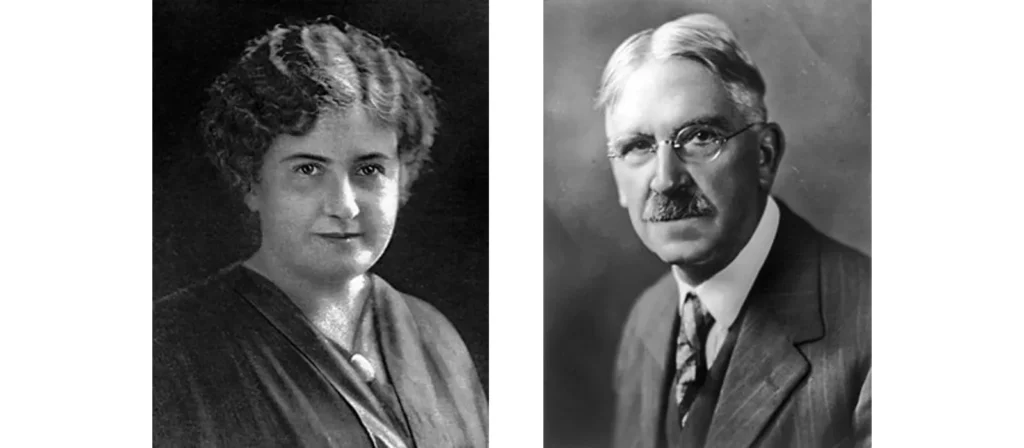
In the mid-20th century, outdoor education began gaining traction through organized models. The Forest School approach, which originated in Sweden and Denmark, brought structured outdoor learning to young children. In the United States, programs like Outward Bound, introduced in the 1940s, used outdoor settings to teach teamwork, leadership, and resilience.
Today, these foundational ideas have influenced modern education systems worldwide. Schools are increasingly integrating outdoor experiences into daily instruction, recognizing their value in supporting cognitive, social, and emotional growth. The renewed interest in outdoor education reflects a return to the belief that meaningful learning often begins outside the classroom.
What Is an Outdoor Classroom?
An outdoor classroom is a structured learning environment located outside the traditional school building. Unlike casual play areas, it is purposefully designed for instruction, offering students a space to engage with lessons while surrounded by nature. These areas often include outdoor classroom furniture like benches, tables, chalkboards, and weather-resistant materials that support various subjects.
In early education, especially in a preschool outdoor classroom, the focus is on sensory development, movement, and exploration. Children interact with natural materials, develop motor skills, and build social connections through guided and independent play. Outside learning environments in this stage support curiosity and creativity while aligning with developmental milestones.
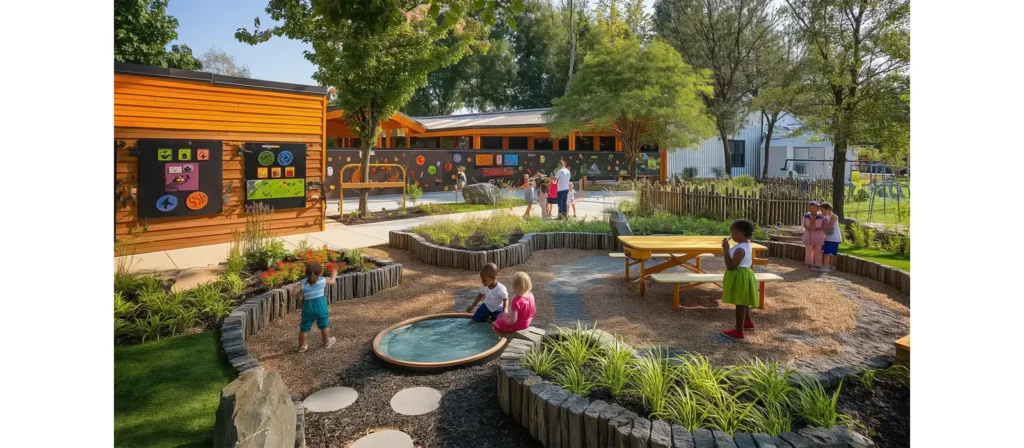
For older students, classrooms outside offer new ways to learn core subjects. Science lessons might involve observing plants or weather patterns, while writing activities can be enriched by the natural setting. Schools use outside-of-classroom learning to promote focus, reduce stress, and create deeper connections to the content. Whether in urban or rural settings, more educators are embracing outdoor classrooms for schools as essential tools for student engagement and well-being.
Why Outdoor Classrooms Are an Essential Addition to Modern Education
Outdoor classrooms are not designed to replace traditional learning environments. Instead, they offer schools a powerful way to support student growth by addressing learning needs beyond the limits of four walls. When used thoughtfully, outdoor settings can strengthen academic engagement, social development, and emotional well-being. The benefits are wide-ranging and significant.
Mental and Emotional Benefits
Learning outdoors provides more than academic support. It nurtures mental well-being. Natural settings are known to lower stress levels, improve mood, and help students regulate emotions. For children who find indoor environments overwhelming, the outdoor classroom offers a calmer and more open space that reduces anxiety and supports better concentration. Many educators observe increased attentiveness and improved behavior during lessons conducted outside.
Academic and Cognitive Improvements
The benefits of outdoor classrooms are well-documented when it comes to cognitive gains. Students who participate in outdoor classroom lessons often retain information better and show more enthusiasm for subjects such as science, math, and language arts. Lessons tied to real-life observations, such as tracking weather, counting natural objects, or writing about the seasons, create stronger connections to the material. This approach supports a range of learning styles and enhances understanding through sensory input.
Social and Behavioural Growth
Outdoor settings encourage collaboration and problem-solving in ways that traditional classrooms often cannot. In outdoor classroom environments, students work together to build, explore, and create. These activities naturally build communication and cooperation skills. Such interactions strengthen peer relationships and improve overall classroom dynamics. Teachers frequently note that students become more respectful, responsible, and self-directed when learning in nature.
Physical Activity and Health Boosts
Being outside invites movement. Students engage in walking, climbing, digging, and hands-on activities that support their physical health. This is especially valuable in outdoor learning for preschoolers, where physical development is closely linked to learning. Exposure to fresh air and natural light also supports better sleep, stronger immunity, and general wellness. All of these factors contribute to improved learning outcomes in both the short and long term.
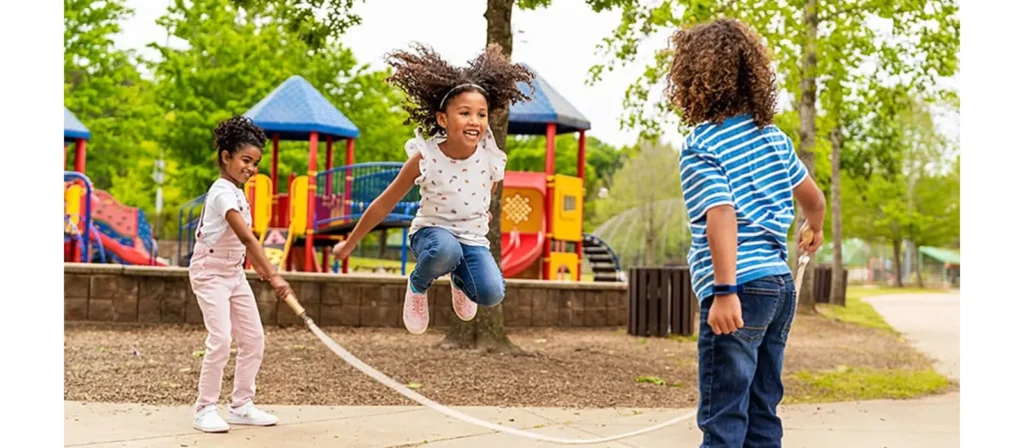
Real‑World Outdoor Classroom Success Stories
To see how outdoor classroom initiatives truly take shape and make a difference, here are three concrete examples from schools that embraced outdoor learning environments and found success.
Urban Middle School: Edison Middle School (Wisconsin, USA)
In May 2025, Edison Middle School held a ribbon‑cutting ceremony for its new outdoor learning space. The space surrounds a stormwater retention area where students helped develop a native pollinator garden, which now serves as a living outdoor classroom. Teachers use this setting not only for science but also for writing and discussion, leveraging real‑world sights, insects, plants, and ecosystems. The partnership with the state forestry education program and local utility company helped fund permanent seating and materials. The result: a visible shift in student engagement, especially during outdoor classroom lessons tied to environmental studies.
Suburban Elementary School: Sustainability Academy Elementary School (Burlington, Vermont, USA)
This school went from being a typical elementary campus to embracing a full‑blown outdoor learning ethos. Starting with garden beds and community input in 2009‑10, the transformation included creating gathering zones, raised beds, and natural materials for play and learning. Shelburne Farms, the project shows how an investment in outdoor learning spaces for schools can evolve gradually over the years, creating a rich ecosystem where students engage in planting, soil analysis, observation, and reflection. Teachers noted that incorporating outdoor classroom design into their plan gave them renewed excitement and a fresh way to teach even core subjects.
Preschool and Early Childhood Model: Breakwater School (Maine, USA)
Breakwater School in Cumberland, Maine, operates on a 22-acre property known as Jessieland, where children from preschool through middle school learn outside daily. The site includes a stream, wooded trails, and open-air learning zones. Students engage in storytelling, environmental observation, planting, and performance. For younger children, the outdoor learning environment is central to the curriculum. This model shows how outdoor classrooms can become foundational in early childhood education and support both creativity and academic development.
Designing an Effective Outdoor Classroom Environment
A well-designed outdoor classroom does more than provide fresh air. It supports learning outcomes by creating a space that is structured, safe, and aligned with educational goals. Effective design considers how students move, interact, and focus in an open-air setting. It blends functionality with natural features to create an environment that supports both teaching and exploration. The following considerations help transform an outdoor area into a successful learning space.
Zoning and Layout Considerations
Every outdoor classroom benefits from having clearly defined zones that mirror indoor functions. These may include a main instructional area with durable outdoor classroom seating, a quiet corner for independent work, and a flexible space for movement or creative activities. Schools often use outdoor classroom benches, large rocks, or tree stumps to establish boundaries and anchor group spaces. Positioning should account for sun, shade, and visibility from all teaching positions. Central placement of a chalkboard, whiteboard, or teaching easel gives structure to lessons and helps direct attention.

Multiple age groups using the same outdoor learning spaces may benefit from modular furniture that can be moved or reconfigured. A reading nook might become a science station depending on the lesson plan. For early learners, proximity to sensory areas, such as sand, water, or garden beds, helps integrate play and instruction naturally.
Safety, Accessibility, and Comfort
Creating an inclusive outdoor classroom design means ensuring that all students can use the space safely and comfortably. This includes level surfaces for wheelchairs or strollers, ramps where needed, and pathways that are easy to navigate in all weather conditions. Seating and table heights should be appropriate for the age group, and options like backrests or shade-providing structures can increase comfort during extended sessions.
Safety considerations also include supervision lines, trip hazards, plant selection, and proximity to fences or roads. Durable outdoor classroom furniture should withstand sun, wind, and moisture. Schools should also plan for secure storage of outdoor classroom equipment, keeping essential materials accessible but protected from the elements.
Environmental and Seasonal Considerations
Climate plays a major role in the usability of outdoor classrooms. Designing for the local environment means accounting for sun exposure, wind direction, rainfall, and temperature changes throughout the year. Trees can offer natural shade, while covered outdoor learning areas like pergolas or fabric canopies provide added protection. Drainage should be assessed to avoid pooling water near seating or walking paths.
In colder regions, some schools install weather-resistant features or portable heating elements to extend seasonal use. Year-round functionality often requires adaptable furniture, storage solutions, and flexible lesson planning. Choosing native plants for gardens not only reinforces environmental education but also reduces maintenance and attracts local wildlife, enriching the outdoor learning environment.
From Inspiration to Action: Tools for Building an Outdoor Learning Space
Why the Right Tools and Materials Matter
Creating an effective outdoor classroom begins with more than just stepping outside. It requires intentional design and the right materials to support meaningful learning. Whether teaching preschoolers or elementary students, educators need environments that are not only safe and engaging but also adaptable to the evolving needs of different age groups and learning goals.
The success of outdoor classroom lessons often depends on how well the space functions day-to-day. If children are uncomfortable, distracted, or unable to access the materials they need, the learning experience suffers. On the other hand, when schools invest in high-quality outdoor classroom furniture, child-sized tables, durable equipment, and play-based learning tools, the outdoor environment becomes just as productive as the indoor one.
More importantly, the right resources support deeper engagement. For younger learners, child-sized tables and preschool outdoor furniture allow them to participate fully and safely. Materials like outdoor kitchens and outdoor art panels encourage hands-on exploration, helping children build independence and creativity while staying connected to the curriculum. With the proper setup, outdoor learning becomes a consistent and rewarding part of the school day.
Outdoor Classroom Furniture Essentials
Creating a reliable outdoor learning space starts with well-chosen furniture. Each piece plays a unique role in how students engage with the environment, stay comfortable, and interact with learning materials. Below are key furniture types used in outdoor classrooms, each designed to support both structure and flexibility in daily instruction.
Picnic tables
Tables are the core of any lesson setup. From group writing tasks to science activities, students need a stable, clean surface to work on. Outdoor classroom tables should be weather-resistant, easy to sanitize, and wide enough to accommodate both materials and movement. For group learning, rectangular or circular tables encourage collaboration. For individual tasks or art projects, smaller pods or folding surfaces work well.
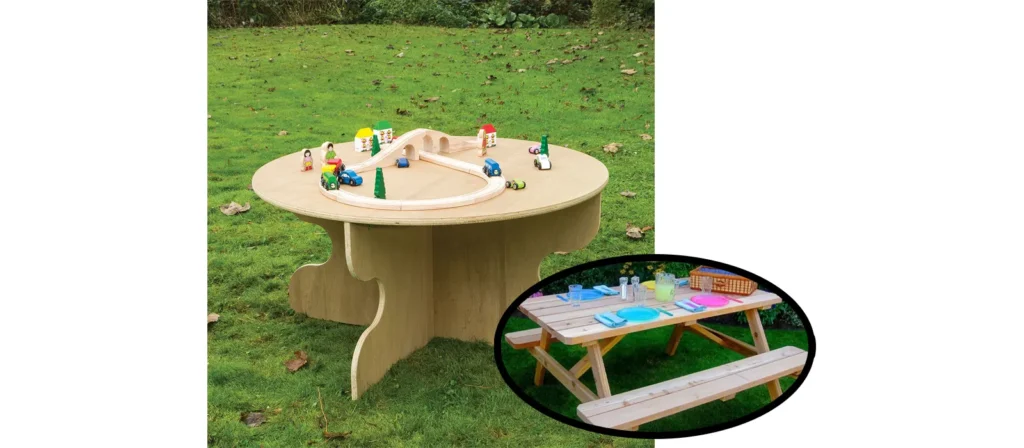
Outdoor Classroom Benches
Benches offer simple, durable seating options that work well in most outdoor settings. Whether arranged in a semicircle for group discussion or lined up for partner work, outdoor classroom benches help define the learning space. Some benches double as storage units, offering a smart solution for compact areas. Choose materials that won’t splinter or absorb moisture, like treated wood or recycled plastic.
Chairs and Stools
In flexible learning areas, lightweight chairs and stools allow quick rearrangement based on activity type. Stackable or foldable options save space and make it easier to switch between different lesson formats. Chairs with back support are especially helpful for longer outdoor sessions. In preschool outdoor classroom settings, scaled-down stools and stackable chairs support comfort and mobility.
Storage Bins and Outdoor Shelving
Outdoor classrooms need smart storage solutions to keep materials organized and protected. Weatherproof storage bins allow teachers to store art supplies, science tools, and toys securely outdoors. Shelving units made from plastic or metal can be placed under covered areas or built into garden walls to keep frequently used items accessible and dry.
Soft Seating and Outdoor Sofas
In relaxed areas of the outdoor learning space, soft seating provides comfort and flexibility. Outdoor sofas, bean bags, or cushioned benches create quiet reading corners, calm-down zones, or collaborative nooks. All materials should be mildew-resistant and easy to clean. These pieces work especially well in covered outdoor learning areas, where they can stay dry and usable throughout the day.
Tutumie ujumbe ikiwa una maswali yoyote au omba nukuu. Wataalamu wetu watakupa jibu ndani ya saa 48 na kukusaidia kuchagua bidhaa sahihi unayotaka.
Educational Toys and Preschool Learning Supplies
Outdoor learning in early childhood is most effective when supported by open-ended, tactile materials that invite movement, creativity, and discovery. These supplies encourage young children to engage deeply with their surroundings while supporting key developmental skills. The right resources turn outdoor time into meaningful instruction that complements both play and formal curriculum goals.
Trikes and Scooters
Tricycles and scooters support balance, leg strength, and coordination. They also offer a sense of independence and freedom. In structured preschool outdoor activity zones, they can be used to teach direction-following, sharing, and turn-taking, all within a movement-rich context.
Climbing Frames and Balance Equipment
Climbing structures like ladders, steps, and bridges challenge children to use their entire bodies while navigating space. Balance beams and stepping logs help develop motor planning and spatial awareness. These tools are cornerstones of effective outdoor play preschool settings.
Sand and Water Play Stations
Water tables, sand pits, and mud kitchens offer rich sensory experiences. Children explore concepts like volume, weight, texture, and cause-effect relationships through tactile interaction. These stations are ideal for educational outdoor activities for preschoolers that encourage experimentation and self-directed learning.
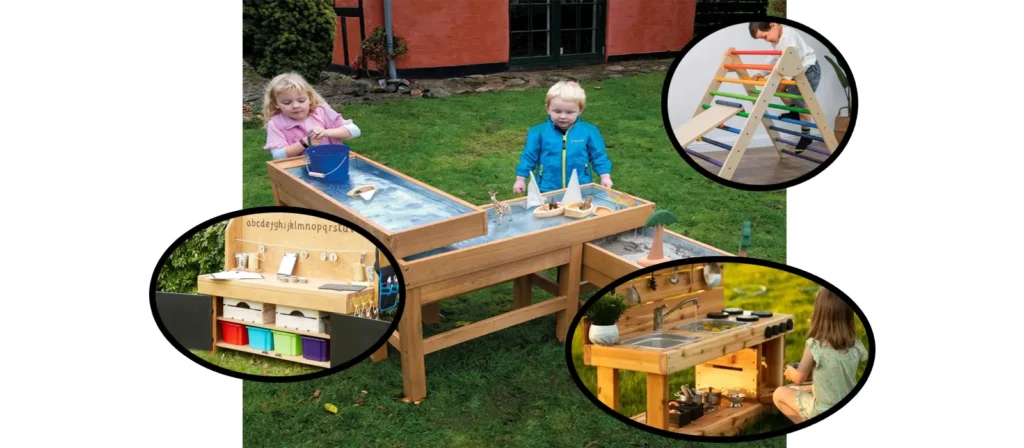
Role-Play and Imaginative Toys
Outdoor kitchens, puppet theaters, and themed play stations allow for creative storytelling and cooperative play. These tools support social development and emotional expression. They also play a key role in the outdoor preschool curriculum, blending free play with skill-building opportunities.
Art and Fine Motor Stations
Chalkboards, painting easels, and craft tables promote creativity while developing hand-eye coordination and early writing skills. Art projects that incorporate natural materials can also enhance environmental awareness in preschool outside programs.
Vifaa vya Kuchezea na Vyombo vya Nje
Loose parts such as buckets, shovels, magnifying glasses, and clipboards turn any preschool outdoor setting into a lab for discovery. These versatile tools support both child-led exploration and teacher-guided lessons. Whether used for digging, sorting, measuring, or observing, they foster curiosity and build early scientific thinking.
Hitimisho
Outdoor classrooms for schools offer more than just a break from indoor routines, they are essential learning spaces that support holistic student development. From preschoolers discovering the texture of soil to middle schoolers discussing ecosystems in a living garden, outdoor classrooms create lasting learning moments. By embracing natural environments as legitimate, structured learning zones, schools empower educators and students alike to rediscover the joy of learning through exploration, movement, and connection.




